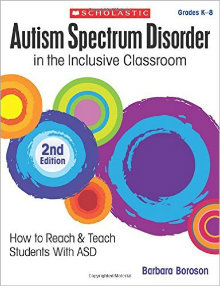Autism Spectrum Disorder in Inclusive Classrooms
Autism Spectrum Disorder in the Inclusive Classroom: How to Reach & Teach Students with ASD
By Barbara Boroson
(Scholastic, 2016 – Learn more)

“One out of every sixty-eight children is believed to be on the autism spectrum-and that number has been rising dramatically for decades.” (U.S, Centers for Disease Control and Prevention, 2014)
The statistics may seem overwhelming and, to some, daunting. These statistics are a wakeup call to some, a reminder to others, and a sad affirmation to those who have been aware of the rise in ASD and the need for educators to learn more about how to reach and teach students with ASD. This book has influenced my life and my teaching. It is indispensable to an educator.

My district has a wonderful opportunity called “Booked for Lunch.” Teachers meet over lunch to share books that they recommend: Children’s Books, Adult Free Choice Book, and Professional Books. I can’t wait until our next meeting to share this book with my colleagues, to tweet out my review, and to shout out on the tallest mountain, ”This book is for YOU!”
Barbara Boroson’s book, which reflects current research in the field of autism, is well organized and provides the educator with useful information and advice to help our students find success.
Throughout the book, she points out that there isn’t just one definition or method to work with students on the autism spectrum. I found comfort and joy in her analogy: “Students on the autism spectrum share some common traits. But just like the stars in the sky, each of these students possesses unique characteristics we can see only when we magnify the details. One of the fundamental goals of this book is to help you look closely enough to see and appreciate the stellar singularity of each student.” (p.5)
Immediately applicable to your classroom
Each of the eleven chapters contains valuable information for the reader to take back to the classroom and immediately practice. I am always looking for new ideas to help promote positive behavior in my classroom. Classroom management skills are critical for any classroom. How we begin the day and end the day can signal what the next day or days might be like. Throughout the book, each of Boroson’s ideas, strategies and classroom techniques all center back to classroom management.
For example, think about setting up your classroom. Teachers love to decorate. How many visits and pins do you have for “Bulletin Boards” on Pinterest? Sometimes, Boroson notes, a classroom can be too stimulating.
“Sensory processing issues can cause a classroom decorated with brightly colored posters or artwork to be visually over stimulating to students on the spectrum. They don’t know where to look; colors swim before their eyes or give them headaches.” (p. 79)
This is not to say you should not decorate your classroom, but when you do, consider what triggers to misbehavior or inattention can be eliminated. So many of Boroson’s practical ideas are applicable to all classrooms, not just inclusive classrooms.
Fresh, easy-to-apply ideas
There are resources and handouts interspersed through the book. One of my favorites is the “Ten Things You Can Do Before Day One” (read here at See Inside). The ideas are fresh, easy to apply, and connected to a chapter in the book. Each of the tips provides the student with an easier transition to school and offers you ways to design your classroom to meet the needs of all students (without breaking the bank or pulling out your hair).
Another one of my favorites is “There’s an App for That” that links technology with the classroom. Did you know there are apps for:
- Sense stimulating apps: Cause and Effect Sensory Light Box – A device for learners with disabilities including autism. It has twenty-one calming or stimulating visual and auditory scenarios that encourage the user to explore.
- Digital Social Stories: Story Maker for Social Stories – An app for creating and presenting stories using pictures, text and audio.
- Model Me Going Places – App for helping children navigate locations in the community. Each location has a slide show to model appropriate behavior.
- Class Dojo – A behavior management system that promotes positive student behavior, keeps parent up to date on student progress and aware of what is happening in the classroom.
Barbara Boroson has presented nationally, is an expert in the field of autism spectrum education, and is the mother of a teenage son with Autism Spectrum Disorder. Her perspective is not only as a researcher or educator, but as a parent. This book is a valuable source of information and advice, written in everyday language. Although it is written for educators, I would also recommend it to parents who want to learn more about ASD and to advocate for their children.
Linda Biondi is a fourth grade teacher at Sharon Elementary School in Robbinsville, NJ and a long-time Morning Meeting practitioner. She’s also the recipient of several educational grants, a Teacher Consultant with the National Writing Project, and a participant on the NJ Department of Education Teacher Advisory Panel and with ECET2 Celebrate Teaching.


































